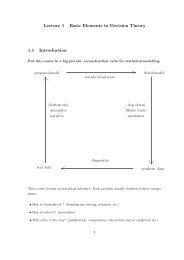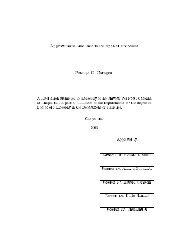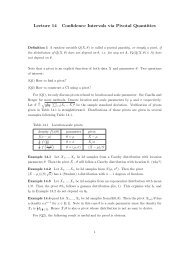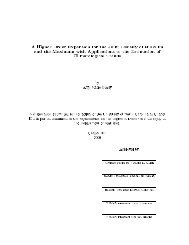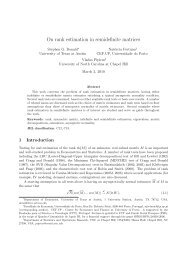Monte Carlo Methods in Statistical Mechanics: Foundations and ...
Monte Carlo Methods in Statistical Mechanics: Foundations and ...
Monte Carlo Methods in Statistical Mechanics: Foundations and ...
Create successful ePaper yourself
Turn your PDF publications into a flip-book with our unique Google optimized e-Paper software.
that isthe second quantization of the operator M T on the energy Hilbert space (see [20,<br />
Section 8] for details). It follows from (5.55) that<br />
<strong>and</strong> hence that<br />
k;(M) n j n 1 ? kL 2 ( ) = kM n k(UA) (5.56)<br />
(;(M) j n 1 ? ) = (M) : (5.57)<br />
Moreover, P is self-adjo<strong>in</strong>t onL 2 ( ) [i.e. satis es detailed balance] if <strong>and</strong> onlyifM is<br />
self-adjo<strong>in</strong>t with respect to the energy <strong>in</strong>ner product, i.e.<br />
<strong>and</strong> <strong>in</strong>this case<br />
MA = AM T (5.58)<br />
(;(M) j n 1 ? ) =k;(M) j n 1 ? k L 2 ( ) = (M) =kMk(UA) : (5.59)<br />
In summary, wehave shown that the dynamic behavior of any stochastic l<strong>in</strong>ear<br />
iteration is completely determ<strong>in</strong>ed by the behavior of the correspond<strong>in</strong>g determ<strong>in</strong>istic<br />
l<strong>in</strong>ear iteration. In particular, the exponential autocorrelation time exp (slowest decay<br />
rate ofanyautocorrelation function) is given by<br />
exp(;1= exp) = (M) (5.60)<br />
<strong>and</strong> this decay rate isachieved by atleastone observable which is l<strong>in</strong>ear <strong>in</strong> the eld<br />
'. In other words, the (worst-case) convergence rate ofthe <strong>Monte</strong> <strong>Carlo</strong> algorithm is<br />
precisely equal to the (worst-case) convergence rate ofthe correspond<strong>in</strong>g determ<strong>in</strong>istic<br />
iteration.<br />
In particular, for Gaussian MGMC, the convergence proofs for determ<strong>in</strong>istic multigrid<br />
[32, 40, 41] comb<strong>in</strong>ed with the arguments ofthe present section prove rigorously<br />
that critical slow<strong>in</strong>g-down is completely elim<strong>in</strong>ated (at least for a W-cycle). That is,<br />
the autocorrelation time of the MGMCmethod is bounded as criticalityisapproached<br />
(empirically 1 ; 2).<br />
6 Swendsen-Wang Algorithms<br />
Avery di erent type of collective-mode algorithm was proposed two years ago 22 by<br />
Swendsen <strong>and</strong> Wang [27] for Potts sp<strong>in</strong>models. S<strong>in</strong>ce then, there has been an explosion<br />
of work try<strong>in</strong>gtounderst<strong>and</strong> whythis algorithm works so well (<strong>and</strong>why it does not work<br />
22 Note Added 1996: Now nearly ten years ago! The great <strong>in</strong>terest <strong>in</strong> algorithms of Swendsen-<br />
Wang type (frequently called cluster algorithms) has not abated: see the references cited <strong>in</strong> the \Notes<br />
Added" below, plus many others. See also [109, 110] for reviews that are slightly more up-to-date than<br />
the present notes (1990 rather than 1989).<br />
45



